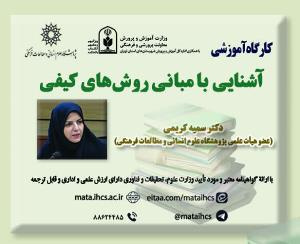امکان سنجی احیای تالاب زرقان در راستای توسعه منطقه ای شهری زرقان (مقاله علمی وزارت علوم)
درجه علمی: نشریه علمی (وزارت علوم)
آرشیو
چکیده
فرآیند توسعه منطقه ای با تکیه بر پتانسیل های طبیعی و زیست محیطی آن گامی بلند در راستای توسعه پایدار است. یافتن مکانهایی که ظرفیت ایجاد هسته های رونق اقتصادی و اجتماعی را در منطقه ایجاد نمایند اولین گام توسعه است. تالاب ها از ذخایر استراتژیک طبیعی مناظق در ایجاد تحولات مثبت در بخش کشاورزی، دامپروری و گردشگری میباشند که متاسفانه بسیاری از آنها دستخوش نابودی بواسطه خشکسالی و یا عملکردهای غلط انسانی شده اند. بخش مهمی از خشکی تالاب ها ناشی از عدم تامین حق آبه تالاب ها و همچنین برداشت بی رویه منابع آب سطحی و زیرزمینی حوضه آبریز تالاب است. هدف از انجام این پژوهش مطالعه امکان احیای تالاب زرقان با استفاده از هدایت جریان سطحی و پساب فاضلاب شهر زرقان و حومه در راستای توسعه منطقه ای می باشد. با در نظر گرفتن سه بخش شرب، صنعت و کشاورزی در منطقه، جهت فرآیند تصمیم گیری در امر تخصیص از مدل حل اختلاف Nash استفاده شده است. نتایج حاصل از مدل شبیه سازی- بهینه سازی تالاب و بیشه زرقان چنان که انتظار می رود نشان داد که در وضعیت موجود مصرف کننده ی بالادست تالاب و بیشه زرقان با صرف هزینه کمتر نیاز آبی خود را تأمین کرده و در ماه های کم آبی با کمبود آبی کمتری مواجه خواهد بود اما بطورکلی برای کل دشت زرقان، با توجه به مقادیر برداشت از آب های سطحی و زیرزمینی که به ترتیب mcm82/1 وmcm32/1 در سال می باشد، نیاز آبی تالاب تامین نمی شود و با کمبود آب به میزان mcm86/1 در سال روبه رو است. نتایج حاصل از شبیه سازی-بهینه سازی و مدلNash در مطالعه ی موردنظر برای سال آبی تالاب نشان داد که سیستم با کمبودهای آبی بسیاری روبرو می باشد و از این جهت امکان احیای تالاب بصورت پایدار با شرایط فعلی نیست.Feasibility study of Zarghan wetland reviving regarding regional development of Zarghan urban area
The process of regional development, relying on its natural and environmental potentials, is a big step towards sustainable development. Finding places that have the capacity to create nuclei of economic and social prosperity in the region is the first step in development. Wetlands are one of the strategic natural resources of the regions in creating positive developments in agriculture, animal husbandry and tourism, many of which, unfortunately, have been destroyed due to drought or human misconduct. An important part of the dryness of wetlands is due to the lack of water rights for wetlands and also the uncontrolled extraction of surface and groundwater resources of the wetland catchment. The purpose of this study is to study the possibility of rehabilitating Zarghan wetland by using surface flow and sewage effluent in Zarghan and its suburbs for regional development. Considering the three sectors of drinking, industry and agriculture in the region, the Nash dispute resolution model has been used for the allocation decision-making process. The results of the simulation-optimization model of Zarghan Wetland and Forest, as expected, showed that in the current situation, the upstream consumer of Zarghan Wetland and Forest provides its water needs at a lower cost, and in the months of water shortage with a shortage. There will be less water, but in general for the entire Zarghan plain, due to the amount of surface and groundwater abstraction, which is 1.82 mcm and 1.32 mcm per year, respectively, the water needs of the wetland will not be met and with a shortage of 86 mcm / 1 per year. The results of simulation-optimization and Nash model showed that the system is facing many water shortages and therefore it is not possible to rehabilitate the wetland stably with the current conditions.







